|
|
 |
 |
|
|
 |
|
Contitech
timing belts
|
 |
|
|
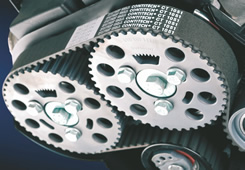
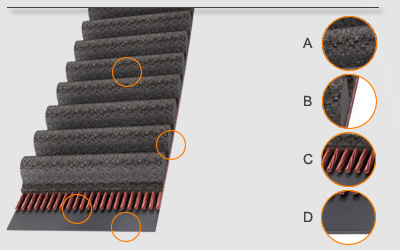
|
|
|
Timing belts enable synchronous positive-fit power transmission in car engines. Their task: To drive camshafts, injection pumps, balancer shafts and other ancillary components. The high quality of the ContiTech timing belts guarantees perfect performance.
Design and function
A timing belt consists essentially of:
A) Polyamide fabric, sometimes also on the belt backing
B + D) Synthetic rubber, sometimes fiber-reinforced
C) Tension member made of glass-fiber
The timing belt controls the precise combustion process in the engine: It drives the camshaft which in turn controls the valves. Its function is particularly important because, if the camshaft and the crankshaft do not run synchronously, the engine will not work. In the worst-case scenario the valves and pistons can collide at full speed with each other in the engine. This results in engine failure!
The timing belt often also takes on additional tasks such as driving the fuel injection pump, the water pump or the balancer shaft.
|
|
|
 |
|
Contitech V-ribbed belts
|
 |
|
|
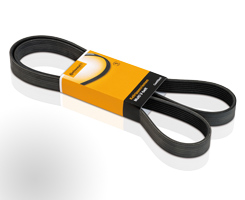
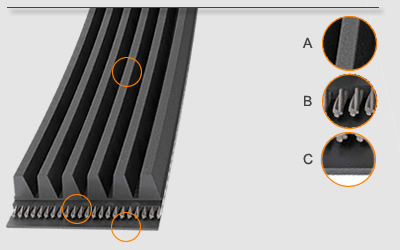
|
|
|
V-ribbed belts enable the non-positive transmission of torque. Their task: To drive alternators, fans, water pumps, AC compressors and power steering systems in modern engines. The high quality of the ContiTech V-ribbed belts guarantees perfect performance.
Design and function
A V-ribbed belt consists essentially of:
A + C) Synthetic rubber, sometimes fiber-reinforced
B) Polyester tension member
Thanks to its flat design with multiple adjacent ribs, the V-ribbed belt offers a large frictional surface area for power transmission within a very small space. Its reverse-bending strength and flexibility enable several units to be driven simultaneously.
|
|
|
 |
|
Contitech ELAST V-ribbed belts
|
 |
|
|
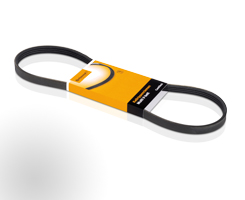
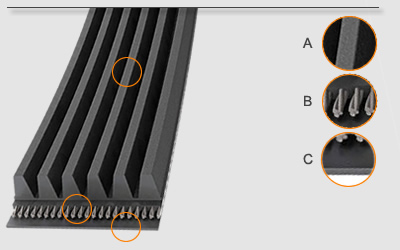
|
|
|
Elastic V-ribbed belts enable the non-positive power transmission of torque in belt drives without a tensioning pulley. Their task: To drive alternators, fans, water pumps, AC compressors and power steering systems in modern engines. The high quality of the ContiTech V-ribbed belts guarantees perfect performance.
Design and function
An ELAST V-ribbed belt consists essentially of:
A + C) Synthetic rubber, sometimes fiber-reinforced
B) Elastic polyester tension member
Unlike normal V-ribbed belts, the ELAST belt has an elastic tension member. The belt is fitted under load and maintains its tension automatically. The belt drive does not have a tensioning pulley.
|
|
|
 |
|
Contitech V-belts
|
 |
|
|
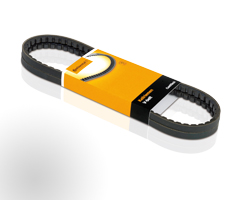
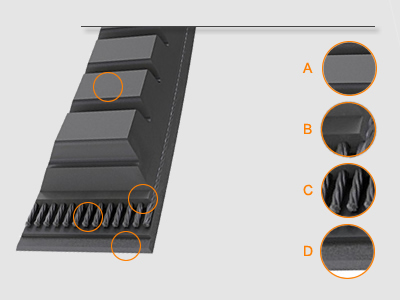
|
|
|
V-belts are classic power transmission elements for the non-positive transmission of torque. Their task: To drive alternators, fans, water pumps, AC compressors and power steering systems The high quality of the ContiTech V-belts guarantees perfect performance.
Design and function
A V-belt consists essentially of:
A) Synthetic rubber base body
B) Tension member bed
C) Polyester tension members
D) Backing fabric
With V-belts, power is transmitted via the static friction on the flanks. They can transmit significantly higher torques than flat belts with the same space requirement. The higher friction on the belt flanks means that the loads on the bearings are substantially lower.
The main field of application is in simple two or three-pulley drives.
|
|
|
|
|
 |
| |
|
|
|
|
| |
 |
 |
| |
|
|
|
|
|
 |
 |
| |
|
|
| |
Our warehouse has thousands of items ready
for delivery. Contact us for
a free quote.

|
| |

|

|

|

|

|

|
| |
|